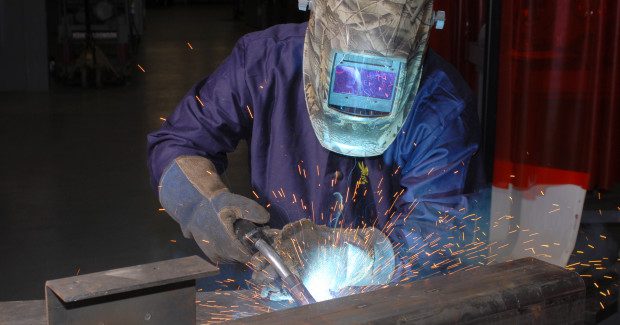Four Things You Must Know About Metal-Cored Wire
In recent years, metal-cored wires have become an increasingly common option to enhance productivity, improve quality and reduce costs in the metal fabrication industry. Here are four important details about metal-cored wire that shops should know if they are considering a filler metal conversion.
Posted: February 19, 2014
With the efforts companies put forth to remain competitive, it’s not surprising that many of them turn to new welding technologies to help. In some cases, a new power source may be the answer, but for others a filler metal conversion may be the best next step. In recent years, metal-cored wires have become an increasingly common option to enhance productivity, improve quality and reduce costs in the manufacturing and fabrication industries.
Here are four important details about metal-cored wire that companies should know if they are considering a filler metal conversion.
No. 1: Metal-cored wires are constructed differently than solid wires
Unlike solid wires, which (as their name implies) are solid throughout, metal-cored wires consist of a hollow metal sheath filled with metallic powders and/or alloys. These ingredients can provide the wires with specific characteristics, including increased weld metal deoxidation, alloyed weld deposits, higher tensile strength and more.
Faced with the challenge of fabricating 5,000 poles for a solar energy installation in a 3.5-month period, Bell Steel Inc. put to work a new side beam welding system powered by the XMT® 450 MPa multiprocess welding inverter and using Metalloy® Vantage™ metal-cored wire from Hobart Brothers. This combination ensured non-stop welding (100 percent duty cycle at 450 amps), excellent travel speeds and deposition rates, and a flatter weld bead that required significantly less post-weld cleanup.
During the welding process, metal-cored wires carry the welding current though the outside metal sheath to the workpiece, resulting in higher current-carrying densities, a broader arc and higher burn-off rates than solid wires. These wires also have a wide penetration profile and generally operate using the “spray transfer” mode of droplet transfer, which reduces spatter generation.
They require a minimum of 75 percent argon (with a CO2 balance) and can weld in the flat, horizontal, vertical-down and overhead positions using a constant voltage (CV) power source. For vertical-up welding, pulse power sources are normally recommended; however, CV equipment can also be used in the short circuit transfer.
No. 2: Metal-cored wires have distinct operating characteristics
Because of their construction and the way they carry the welding current, metal-cored wires generate very low levels of spatter and work well to bridge gaps present in the weld joint. They offer good weld penetration, high deposition rate and faster travels speeds than solid wires.
Metal-cored wires can also help minimize certain weld defects. Specifically, due to their ability to “wet in” to the weld joint smoothly and provide good sidewall fusion, the wires can minimize lack of fusion and undercut. In some cases, metal-cored wires can also operate with lower heat input to reduce part distortion.
Other unique operating characteristics include the ability to provide low hydrogen welds that minimize under-bead cracking and reduced silicon deposits at the toes of the weld.
No. 3: Metal-cored wires are best-suited for specific applications
Metal-cored wires are available in mild steel, various low-alloy steels and stainless steel types, making them ideal for a wide range of materials. They are particularly well suited for heavy equipment manufacturing, automotive welding (chassis or wheels, for example) and rail car manufacturing. They are also good for robotic and automated welding operations, where their full potential for increased deposition can be achieved.
Metal-cored wires can weld through light rust and mill scale, on applications with 1/4-inch and thicker plate, and also on thinner materials like cold rolled steel or even stainless steel frequently found in petrochemical or food industry applications. Further, the wires can be used for applications that require aesthetic bead appearances, those with poor fit-up or applications prone to burn-through.
The wires’ ability to “wet-in” also make them well suited for welding a variety of different types of tanks; in fact, many tank manufacturers have reported a drastic reduction in their reject rate since converting to metal-cored wire. Metal-cored wires are generally not recommended for applications that require a lot of out-of-position welding.
No. 4: Metal-cored wires can often eliminate pre- and post-weld activities
Metal-cored wires are often selected by companies for their ability to reduce labor and costs in the pre- and post-weld areas of the welding operation. Because metal-cored wires can weld through mill scale and light rust, they can often eliminate pre-weld activities like grinding, sandblasting or adding anti-spatter before the welding process begins.
This feature can also eliminate or reduce the cost for purchasing grinding wheels and anti-spatter solution. And it can minimize the need to clean anti-spatter solution, as it’s not uncommon for it to build up on machinery or the floor in the areas it is used. The lack of spatter generation can also help companies eliminate post-weld grinding and other types of cleanup in this area of the welding operation.
In certain cases, the elimination of pre- or post-weld activities can allow companies to reallocate labor elsewhere in the welding operation to help improve productivity, a benefit that can reduce overall labor cost for activities that don’t directly contribute to the operation’s throughput.
For more information on metal-cored wires, contact a trusted welding distributor.
















